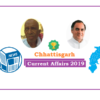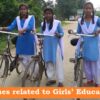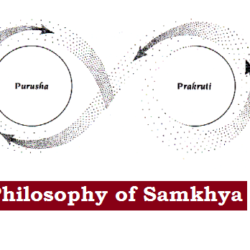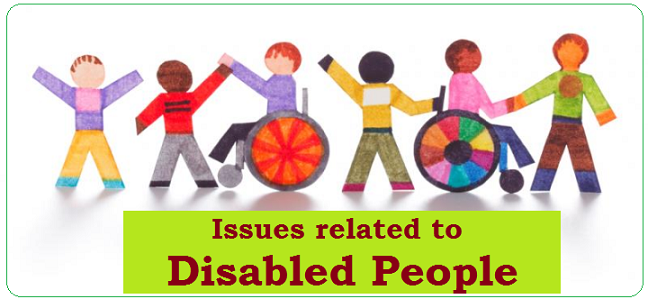
Throughout centuries, the disabled have been oppressed, marginalized and stigmatized in almost all societies. They constitute a section of the population, which is most backward least served and grossly neglected. They have been socially, educationally and economically disadvantaged; thus having customarily denied their right to self-assertion, identity and development.
Life is made difficult not so much by the individual’s medical condition, but mainly by a hostile physical and social environment which excludes disabled people from all spheres of social life. It is not the medical impairment, but the way in which society reacts to it, that exclude disabled from taking part in celebration, political decision-making or religious.
As per 2011 census disabled people constitutes 2.21 per cent of the total population. However, as Census depends on self-reporting of disability which may leave out mental and even physical disability.
Prime Minister Narendra Modi had during his radio address “Mann Ki Baat” on December 27, 2017 said that physically- challenged people have a “divine ability” and the term “divyang” should be used in place of “viklang” for them.
Concept and Meaning:
Disability is not all alone; sometimes impairment and handicap are used interchangeably, but these terms have different meanings and describe different concepts. To promote appropriate use of these terms, in 1980 the World Health Organization (WHO) established the international classification of impairment, disability and handicap, which define these concepts:
- Impairment: refers to the loss or abnormality of psychological, physical, or anatomical structure or function at the system or organ level that may or may not be permanent and that may or may not result in disability.
- Disability: refers to an individual limitation or restriction of an activity as the result of impairment.
- Handicap: refers to the disadvantage to the individual resulting from an impairment or disability that presents a barrier to fulfilling a role or reaching a goal.
The definition of disability as provided by UN Convention on Rights of Persons with Disabilities (UNCRPD) states that
Persons with disabilities include those who have long term physical, mental, intellectual or sensory impairments which in interaction with various barriers may hinder their full and effective participation in society on an equal basis with others.
Factors of Disability:
- Genetic or medical factors: disease or hereditary problems
- Poverty: Poor families often do not have sufficient income to meet their basic needs. Inadequate shelter, unhygienic living conditions, lack of sanitation and clean drinking water combined with poor access to health facilities lead to disability.
- Malnutrition: Malnutrition increases susceptibility to disabling conditions.
- Occupational Hazards: Around 90% of the workforce in India is in the unorganised sector, which is characterized by low levels of technology, low standards of safety and hazardous working conditions.
- Crime: Violent crimes underline shortcomings in the social, political and economic arrangements of a society. Many children and women are abducted to be used in prostitution, slavery and beggary.
- Traffic Hazards: Unplanned cities with narrow roads, rapid growth in number of vehicles and disregard of traffic regulations have been responsible for increasing the number of road accidents in India.
- Wars: War has been the single largest factor responsible for causing permanent disablement not only to combatants in the battlefield but also to civilians who are forced to bear the hazards of lethal, chemical and nuclear weapons.
Challenges faced by Disable People:
- Inaccessibility: Most of the government buildings or private offices and other infrastructure are inaccessible for disabling population.
- Barriers to health care: Affordability of health service and transportation are two main reasons why people with disabilities do not receive needed health care.
- Non- inclusive education system: Inaccessible school buildings, unavailability of specially trained teachers, disability sensitization in curriculum not included.
- Attitudinal barriers: Stigmatization and discrimination deny people with disabilities their dignity and potential to achieve equality of opportunity and social integration.
- Inaccessible communication systems: It prevents access to information and knowledge and opportunities to participate.
- Institutional barriers: Institutional barriers include many laws, policies, strategies or practices that discriminate against people with disabilities by not taking their needs into account.
- Poor implementation: Poor implementing policies and plans can prevent the inclusion of people with disabilities.
- Inadequate research and data: Inadequate research on disability and implementation of various schemes with lack of data hinders proper implementation and initiatives regarding integration of disable people.
Constitutional Framework for safeguarding Disability Rights:
- Article 14: No person will be denied ‘equality’ before the law
- Article 15: Government not to discriminate against any citizen of India (Including disabled) on the ground of religion, race, caste, sex or place of birth.
- Article 17: No person including the disabled irrespective of his belonging can be treated as an untouchable
- Article 21: Every person has right to life and liberty guaranteed.
- Article 21A: Free and compulsory education for all children (including the disabled) until they attain the age of 14 years.
- Article 23: There can be no traffic in human beings (including the disabled) and beggar and other forms of forced labour is prohibited
- Article 29: No citizen shall be denied admission into any educational institution maintained by the State or receiving aid out of State funds on the ground of religion, race, caste or language.
- Article 32: Every disabled person can move the Supreme Court of India to enforce his fundamental rights and the rights to move the Supreme Court.
Acts of Parliament for safeguarding Disability Rights:
- The Rehabilitation Council of India Act 1992:
- Act sets out to regulate the training of professionals in rehabilitation and sets out a framework for a Central Rehabilitation Register.
- The major functions of the council include the recognition of qualifications granted by Universities in India for Rehabilitation Professionals.
- The Persons with Disabilities (Equal Opportunities, Protection of Rights and Full Participation) Act (PWD Act) 1995:
- This act provides 3% reservations for disabled people (blind or low vision, hearing impairment and locomotor disability or cerebral palsy) in poverty alleviation programs, government posts, and in state educational facilities, as well as other rights and entitlement).
- Prevention and Early Detection of Disabilities
- Relaxations for ensuring employment of person with disabilities are: Training and welfare, Relaxationof upper age limit, Regulation the employment, Health and safety measures.
- Affirmative Action: Preferential allotment of land for certain purpose- house, setting up business; setting up special recreation centers, establishment of factories by entrepreneurs with disability.
- National Policy for Persons with Disabilities Act 2005:
- It recognizes that Persons with Disabilities are valuable human resource for the country and seeks to create an environment that provides equal opportunities, protection of their rights and full participation in society.
- Its aim is to ensure better coordination between various wings of the State and Central Governments.
- It focuses on: Prevention of Disabilities, Rehabilitation Measures, Early Detection and Intervention, Counseling and Medical Rehabilitation.
- Extensive infrastructure has been developed in India for disabled persons under this Act and includes the establishment of the following institutions among others:
- Institute for the Physically Handicapped, New Delhi,
- National Institute of Visually Handicapped, Dehradun,
- National Institute for Mentally Handicapped, Secunderabad
- Rights of Persons with Disabilities Act, 2016:
- The Act replaces the PwD Act, 1995 and also fulfills the obligations to the United National Convention on the Rights of Persons with Disabilities (UNCRPD), to which India is a signatory.
- The types of disabilities have been increased from existing 7 to 21. It also defines persons with benchmark disabilities as those with at least 40% of any of the above-specified disabilities.
- Additional benefits such as reservation in higher education- 5%, employment- 4%), allocation of land, poverty alleviation schemes- 5%, etc.
- Right to education from 6 to 18 years of age.
- Creation of National and State Fund will be created to provide financial support to the persons with disabilities.
- Penalties for offences committed against persons with disabilities and special courts will be designated in each district to handle cases concerning violation of rights of disable.
Accessible India Campaign (Sugamya Bharat Abhiyan):
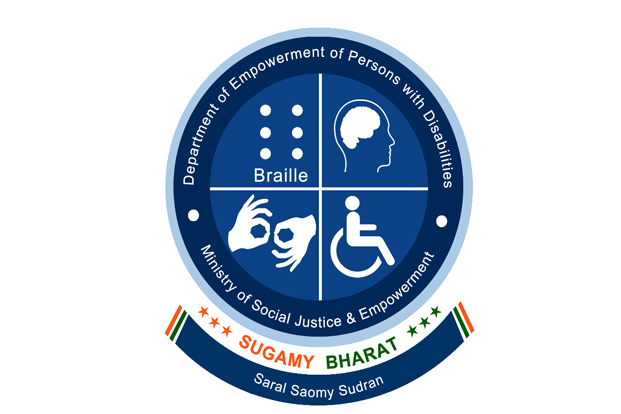
The aim of the Campaign is to make a barrier free and conducive environment for Divyangjans all over the country. It was launched by the Prime Minister Shri Narendra Modi on International Day of Persons with Disabilities on 3rd December, 2015. The campaign is based on the principles of the Social Model of Disability, that disability is caused by the way society is organised, and not the person’s limitations and impairments. A barrier-free environment facilitates equal participation in all the activities and promotes an independent and dignified way of life.
The main focus areas are:
- Built environment accessibility: accessible (with ramps, etc) government buildings, tourist spots, airports, railway stations, etc
- Transportation system accessibility: accessible transport facilities with ramps, toilets, lift with Braille Symbols and Auditory Signals.
- Information and communication accessibility: internet technology for differently-abled people, accessible Govt websites.
- Accessible Television programmes by incorporation of features like captioning, text to speech and audio description
- ‘Sugamya Pustakalaya’– an online library for Persons with Print Disabilities has been launched.
Schemes for Disabled People:
- Deendayal Disabled Rehabilitation Scheme (DDRS):
- Pre-Schools and Early Intervention and Training
- Special Schools for Persons with Disabilities
- Rehabilitation for Persons with Disabilities
- Human Resource Development
- Scholarship for Pre-matric to post-matric and post graduation level for students with disabilities
- Central Sector Plan Scheme of Free Coaching for competitive examinations for Students with Disabilities
- National Fund for Persons with Disability:
- The RPwD Act 2016 mandates constitution of the National Fund for persons with disabilities.

 Home
Home Syllabus
Syllabus Contact Us
Contact Us

